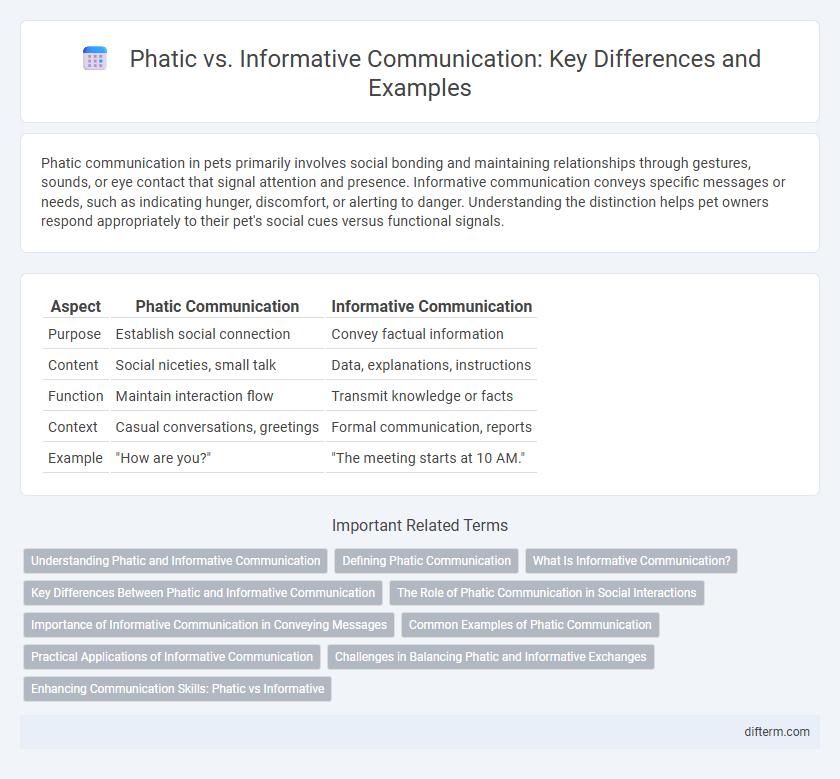Phatic communication in pets primarily involves social bonding and maintaining relationships through gestures, sounds, or eye contact that signal attention and presence. Informative communication conveys specific messages or needs, such as indicating hunger, discomfort, or alerting to danger. Understanding the distinction helps pet owners respond appropriately to their pet's social cues versus functional signals.
Table of Comparison
| Aspect | Phatic Communication | Informative Communication |
|---|---|---|
| Purpose | Establish social connection | Convey factual information |
| Content | Social niceties, small talk | Data, explanations, instructions |
| Function | Maintain interaction flow | Transmit knowledge or facts |
| Context | Casual conversations, greetings | Formal communication, reports |
| Example | "How are you?" | "The meeting starts at 10 AM." |
Understanding Phatic and Informative Communication
Phatic communication serves primarily to establish or maintain social relationships without conveying significant information, often through greetings or small talk. Informative communication focuses on the clear and accurate transmission of data, facts, or instructions to achieve understanding or inform decisions. Recognizing the distinction between phatic and informative communication enhances interpersonal interactions and ensures appropriate message delivery in various social and professional contexts.
Defining Phatic Communication
Phatic communication involves brief exchanges focused on social bonding rather than the transmission of detailed information, such as greetings or small talk. It maintains interpersonal relationships by establishing a connection without conveying significant content. Unlike informative communication, which aims to share facts or knowledge, phatic interactions prioritize social cohesion and emotional rapport.
What Is Informative Communication?
Informative communication delivers clear, factual, and detailed messages aimed at educating or providing knowledge. It prioritizes accuracy, relevance, and clarity to ensure the receiver fully understands the content. This type of communication is essential in academic, professional, and technical contexts where precise information exchange is critical.
Key Differences Between Phatic and Informative Communication
Phatic communication primarily serves social functions, focusing on establishing or maintaining social relationships through greetings, small talk, and other social rituals, without exchanging significant information. Informative communication aims to convey clear, factual content or knowledge, ensuring the receiver understands and processes specific information. The key differences lie in purpose, content depth, and context: phatic is relational and superficial, while informative is content-driven and data-centric.
The Role of Phatic Communication in Social Interactions
Phatic communication serves as a social lubricant by establishing and maintaining interpersonal connections through greetings, small talk, and other ritualistic exchanges that do not convey substantial informational content. Unlike informative communication, which aims to transmit specific knowledge or data, phatic communication reinforces social bonds, eases social tension, and facilitates smoother interactions in personal and professional settings. Its role is crucial in creating a comfortable environment that encourages open and effective communication among participants.
Importance of Informative Communication in Conveying Messages
Informative communication plays a crucial role in clearly conveying facts, instructions, and data, ensuring accurate understanding and effective decision-making. Unlike phatic communication, which primarily serves social bonding and establishing connections, informative communication prioritizes content clarity and message precision. This type of communication is essential in professional, educational, and technical contexts where the accuracy of information directly impacts outcomes and productivity.
Common Examples of Phatic Communication
Common examples of phatic communication include greetings such as "Hello," small talk about the weather, and simple inquiries like "How are you?" These exchanges serve to establish rapport and social connection rather than convey significant information. Phatic communication plays a crucial role in maintaining social bonds and easing interactions in daily communication.
Practical Applications of Informative Communication
Informative communication plays a crucial role in professional settings by enabling clear transmission of data, instructions, and ideas, which enhances decision-making and operational efficiency. Unlike phatic communication that primarily serves social bonding, informative exchanges provide concrete content necessary for task completion and knowledge sharing. Practical applications include presentations, reports, and training sessions where accurate, detailed information facilitates learning and collaboration.
Challenges in Balancing Phatic and Informative Exchanges
Balancing phatic and informative communication involves challenges such as maintaining social connection without sacrificing clarity and efficiency in information exchange. Overemphasis on phatic elements can lead to vagueness, while too much focus on informative content may hinder rapport building and create communication barriers. Effective communicators must navigate these dynamics to foster meaningful interactions that satisfy relational and informational needs simultaneously.
Enhancing Communication Skills: Phatic vs Informative
Phatic communication primarily serves to establish social connections and maintain interpersonal relationships, often through small talk or greetings, which enhances rapport and trust. Informative communication focuses on conveying clear, factual information to ensure understanding and effective decision-making. Mastering both phatic and informative communication skills improves overall interaction by balancing social bonding with clarity and precision.
phatic vs informative Infographic

 difterm.com
difterm.com